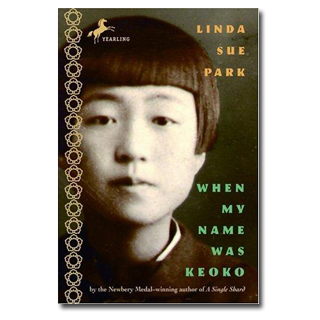
A FEW OTHER EVENTS FOR
JUNE 6:
- Happy birthday Maxine Kumin (What Color is Ceasar?, The Microscope), Peter Spier (People, The Fox Went out on a Chilly Night), Cynthia Rylant (The Relatives Came, When I Was Young in the Mountains), Geraldine McCaughrean (The White Darkness, Peter Pan in Scarlet).
- It’s the birth date of Will James (1892-1942), Smoky, The Cowhorse, Verna Aardema (1911-2000), Why Mosquitoes Buzz in People’s Ears, and Miriam Schlein (1926-2004), Year of the Panda.
- It’s National Yo-Yo Day. Read Knots in My Yo-yo String by Jerry Spinelli; Yo-Yo Man by Daniel Pinkwater, illustrated by Jack Davis; and Yo? Yes! By Chris Raschka.
Today Koreans celebrate Memorial Day — to pay tribute to those who died in war. Although very few books for children are set in Korea, Linda Sue Park’s extraordinary novel When My Name Was Keoko, published in 2002, explores World War II as seen by Korean citizens.
For this powerful novel, Linda Sue Park, winner of the Newbery medal for A Single Shard, interviewed members of her Korean family for details about their experience during World War II. Set in Korea right before the Japanese attack on Pearl Harbor, the novel is narrated by two engaging protagonists, Sun-hee, age ten, and her older brother Tae-yul, thirteen. Forced to give up their Korean names and abandon the Korean language, the two struggle to deal with the Japanese occupation of their home. Sun-hee studies hard, hoping to become a scholar like her father. Tae-yul rebels, hating the Japanese history lessons forced down his throat.
Their uncle, who becomes a member of the Korean resistance, must leave home to escape capture. Their father tries to survive passively. Toward the end of the war, Tae-yul signs up for the Japanese army and receives training to become a Kamikaze pilot. In one of the most chilling chapters in children’s fiction, he and other young men prepare for their final suicidal flight.
Park weaves history and culture, family and friendship, deprivation and life’s joys together seamlessly in this novel. Although she does not avoid the horrors of the situation, she brings the events to a hopeful and happy conclusion—a free Korea where the young people can have their own names and customs. When My Name Was Keoko, in fact, ends with two young people practicing their once-forbidden Korean language.
When My Name Was Keoko explores the tremendous upheaval of war, the fate of minority people in times of crisis, and the power of language to shape identity. For any adult or child ages ten through fourteen seeking information about the significance of Korean Memorial Day, When My Name Was Keoko brings these historic events alive and makes readers understand why this day in history needs to be celebrated. Once readers encounter it, they will never look the same way on the war in the Pacific during World War II.
Here’s a passage from When My Name Was Keoko:
It wasn’t fair. Why couldn’t girls ride bicycles? It wasn’t like the old days when girls had to wear long skirts. Omoni still wore long skirts, and so did a lot of older women. But young women and girls like me wore trousers. Omoni had told me it was the Japanese who had brought in this style. A lot of people hadn’t liked it, but I couldn’t understand why. Trousers were much easier to wear, and better for playing in.
Originally posted June 6, 2011. Updated for .













I loved this book, although there really isn’t anything by Linda Sue Park I HAVEN’T loved.
This was a WWII story I definitely had not heard before reading this book based on her family’s experience in Japan as Koreans.
ooh, another book to add to my growing list…last night I shared The Arrival with a friend who is going to get one for herself and one for her 10 year old niece.
Suzi: Thanks for the report on The Arrival.
Jory: Yes, the book really brings a perspective we don’t have in this country. I agree. Linda Sue rocks!
I’m really looking forward to reading this, especially since I just finished compiling a recommended booklist on WWII for Asian Pacific American Heritage month. The stories all touched me, particularly “So Far from the Sea” by Eve Bunting and “Passage to Freedom: The Sugihara Story” by Ken Mochizuki. AdLit.org also has a booklist about different perspectives in WWII for older readers as well.
http://www.colorincolorado.org/read/forkids/asianpacific/worldwar2
http://www.adlit.org/books/c883
I will never forget the terrifying creep of erasure in this novel … as not only the Korean language and Korean customs are forbidden, but finally, the history of the country itself disappears. It’s so eye-opening to see this from the point of view of individuals, and to see how it goes stage by stage, until there’s nothing left.
mta
Another great series that deals with Korea during WWII is The Year of Impossible Goodbyes by Sook Nyul Choi. The second book is Echoes of the White Giraffe, and the trilogy concludes with A Gathering of Pearls. It’s told from the perspective of a Korean girl and her journey from before the occupation to her higher education.
Tahleen
Loved this book! I reviewed it for my high school’s “Teacher’s Recommendations in the Library” video in Seoul. Most Koreans have never heard of this book, though it exists in Korean translation. It was interesting to be that bridge.